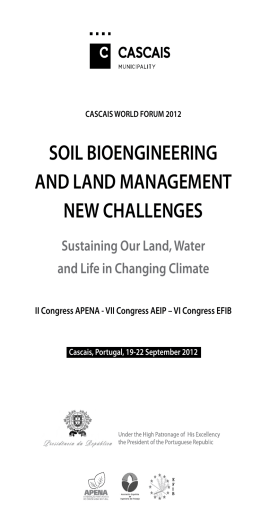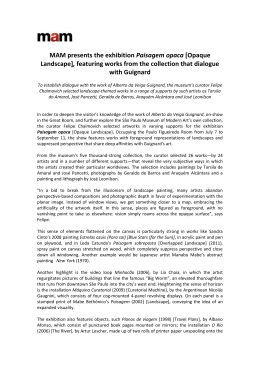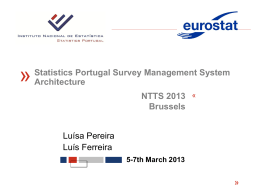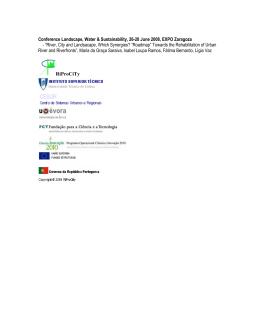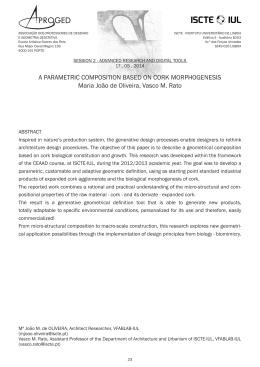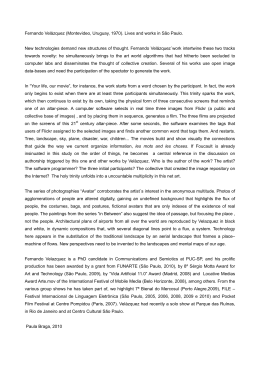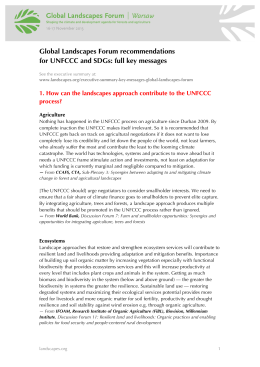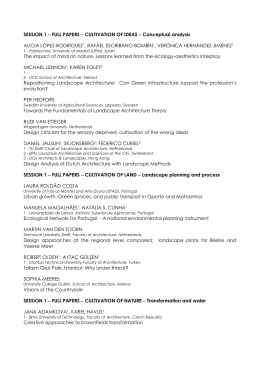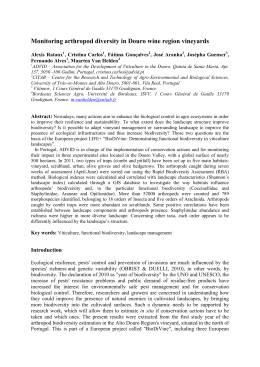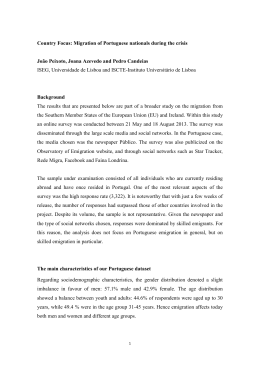LANDSCAPE PREFERENCES OF MONTADO AND DIFFERENT TYPES OF MONTADO D. Ježová and Teresa Pinto-Correia Department of Biophysical and Landscape Planning, Colégio Luís Verney, University of Évora, 7 000 Évora, Portugal E-mail: [email protected] Abstract The paper explores preferences of Montado and different types of Montado by landowners and land-users. This assessment is required to obtain knowledge about people’s relation to landscapes, to be included in future planning and in management options of multifunctional landscape. The methodology for identification of landscape preferences used in this work is based on face-to-face interviews and photographs of landscape as visual stimuli. The focus groups were landowners, workers and residents in district of Coruche. Results from 50 interviews shows that Montado is the most preferred landscape type between the other landscape types in region. The most preferred type of Montado of Cork Oak is that of combination of silvo-pastoral system with clean understorey from shrubs and land cover about 40-60% by adult trees. Keywords: multifunctional landscapes, landscape preferences, values, photographs Introduction This work makes part of interdisciplinary project Agroreg formed as a reaction to problem of landowners with sustainable management of Montado of Cork Oak. The main objective of project is to create a decision support system for landowners and evaluation of economic, social and environmental influence of management practices. In this complex project, objective of present work is to find contributions for management of Montado like multifunctional system by identification of landscape preferences. Incorporation of human preferences needs and activities in the management plans safeguard their continuation and success (Pavlikakis at all, 2005). The challenge of multifunctionality in rural landscape is accepted as an aim for landscape management, both in the scientific community and also already in the definition of policy objectives, e.g. the Second Pillar of the Common Agricultural Policy. 1 The different functions of post-modern landscape have to satisfy the needs and expectations of society. Montado is appreciated in various ways, but it is unclear what kind of Montado is preferred for what activities. This problem makes difficulties for landscape planners and decision makers to integrate different activities in management. Primary it is needed to define the values and needs of society in Montado. This is intended to explore in this work by evaluation of landscape preferences of different groups of people who manage and use the Montado in different ways. This knowledge will be important contribution of decision support system for management of Montado as a multifunctional system. Even though that people are important component of traditional landscapes and its persistence directly depends on their actions (Plieninger at all, 2004) in Portugal are lack of studies about Montado functions and their integration in management. Understanding the landscape preferences destined to finding values that are attributed to Montado by landowners and different groups of land-users. That helps to define socially attractive functions of Montado and to implement them in the future planning. Landowners with their activities and management choices influence evolution of landscape changes. Furthermore, various groups of landscape users, including inhabitants, consider the landscape in different ways, according to the functions expected. Thus, the knowledge about their preferences in relation to pattern and in relation to the function has to be integrated in the future planning of the landscape. Differences in management create a range of Montado types. The work’s aim is to explore the value of different Montado types to landowners and to land-users. Gwoth and Van den Born divide landscape preferences research in 3 scales. 1- preferences for landscape types in general and verbal terms 2- preferences for landscapes elicited as in most landscape preferences studies, i.e. visualized and depicting more concrete landscapes and 3- preferences for landscapes as expressed in concrete behaviours of daily life, such a picnic, play, recreation from daily stress, etc. To present work is relevant this scale of landscape preferences research. Montado The Montado is the agro-silvo-pastoral system dominant in the southern part of Portugal already existing for many centuries, in more or less developed and intensive management forms. Commonly it is formed by open evergreen oak woodlands. The dominant species of trees are Cork oak (Quercus suber, L.) or Holm oak (Quercus ilex, ssp. Rotundifolia, L.). Traditionally this system is exploited by multiple land use, combining the exploitation of the tree cover, and a rotation of grazing, cultivation and 2 Eliminado: (was) a b c d e f g Figure 1. Photos of seven different landscape types studied in this work. Intensive cultures (a); Vineyard (b); Olive grove (c); Montado (d); Eucalyptus grove (e); Pinus pinea grove (f) and Pinus pinaster grove (g). 3 fellow in the under cover. The principal product of Montado of Cork oak is cork as a Eliminado: products of Montado of Cork oak forestry product, livestock breeding as a pastoral product and cereals as a cultivation Eliminado: are product. This last one has been decreasing radically in the last decades, being the system now mainly a silvo-pastoral system. Research questions of this work are: “How preferred is Montado between others landscape types?” and “How preferred are different types of Montado?” Materials and methods Study area The study area, classified by project Agroreg, is municipality of Coruche. This municipality makes part of extensive moor of Ribatejo, interrupted by valley of Sorraia characterized by intensive agriculture. Fertile areas are occupied by permanent cultures, as orchards and vineyard and by annual cultures as rice, maize, tobacco, beet, tomato and by horticultures. A very softly rippled relief characterizes moor of Ribatejo that is associated to Montado of Cork Oak. Characteristic are big properties with extensive explorations of Montado or plantations of eucalyptus and pine. District has low population density (20 people for km2). Population is concentrated in big villages and in small peripheral villages. The use of photographs as stimuli: The photographs in this study were used to facilitate communication with people about their preferences in landscape. People are generally receptive to photographs and want to see them. A page of text is rarely met with the same enthusiasm. Humans are visual animals (R. Kaplan, 1979). Photographs are quite realistic representations, and permit a better control by the researcher of the conditions under which the landscapes will be perceived (atmospheric and light conditions, number and type of elements present, etc.). Another advantage is that it is also possible for a given subject to simultaneously compare several photographs (Real, 2000). About 500 colours slides were taken from July to September 2004 in study areas of project Agroreg using a Minolta DiMAGE A1 camera. The aim was to capture the different types of rural landscapes and different types of Montado of Cork Oak with adult trees, on clean days, in areas with almost flat horizon, without presence of manmade elements (roads, electric power lines, farm-buildings etc.) and with absence of water components. Finally, the photographs were selected or manipulated with computer technology, for example, to eliminate differences in sky colour or to 4 manipulate presence of livestock on the scene. It was obtained seven pictures of rural landscapes (Figure 1) and fourteen pictures of Montado of Cork Oak (Figure 2). Montado is an extremely flexible system, with many variants of management options and densities, resulting in a high variation in types. Therefore, the more significant aspects for the project Agroreg were selected. These are related not so much with the bio-physical characteristics, but with the management of the Montado by land owners. These combinations result in quite different types of landscapes, and may support different uses. The combination of four elements: land cover, composition of trees, shrubs presence and livestock presence results in fourteen slides (Table 1). A simplification had to be admitted, as not all possible variations of the Montado could be considered. Land cover% Composition of trees Shrubs presence >10 irregular without shrubs without shrubs irregular with shrubs 40-60 without shrubs in line with shrubs > 60 irregular with shrubs Livestock presence without animals with sheep with cows without animals with sheep with cows without animals with sheep without animals with sheep with cows without animals with sheep without animals Nº 1 2 3 4 5 6 7 8 9 10 11 12 13 14 Table 1 - Table of settings visualized in fourteen photos of Montado types resulting from different management of Montado. The landscape variables used for the study were: 1. Land cover (<10%, 30-60%, >80%) as a result of different intensity of management. Management affect the vegetation structure in composition of trees and under storey structure. The open landscape with land cover less than 10% present intensification in Montado by agricultural production. The landscapes with land cover more than 80% present extensification of traditional grazing practices, usually without pasture. 5 2. Composition of trees (in line or irregular). The new plantations are usually makes in line for reason of simplification to access of mechanization. Irregular composition of trees usually resulting from natural regeneration. 3. Under storey structure (without or with shrubs). Different frequencies of shrub cleaning create different visual aspects. 4. Presence of livestock (without livestock / with cows / with sheep). Data collection Participants for this study were contacted through Association of Forestry Producers in Coruche (APFC). The group was made up of landowners (N = 7), workers from properties (N = 22) and residents of Coruche (N = 21). It was carried out 50 face to face interviews during one month with people from district of Coruche. The interview was made with each subject individually. At the beginning of the interview, the respondent gives a short introduction on the purpose of the interview. All questions were readied aloud by the interviewer. Responses for open questions were fully described. The average time for completing the interview was twenty five minutes. Each interviewee gets asked the questions in the same the same order. Configuration of photographs on the table was changed randomly for each respondent with goal to eliminate the effects of presentation order. The first part of the interview consisted from questions about preference of landscape type. Each respondent was asked to point out his favourite combination of the three landscapes from seven photos and subsequently to choice the most preferred landscape type. Next he was asked to try to explain their choices by open-ended question. The second part of the interview consisted from questions about Montado type preference. The main purpose of this part is to evaluate differences between the landowners and land-user groups in the relationships with Montado landscape elements. In this part was repeated the same procedure from first part, but using the fourteen photos of Montado types. 6 1 2 3 4 5 6 7 Figure 2.Photos of Montado types related with different management by landowners. 7 8 9 10 11 12 13 14 8 Results and discussion Data from responses for closed questions was analyzed with SPSS program. Landscape type The most frequently selected combination of landscape types was the vineyard with Montado and Pinus pinea grove, preferred by 16% of respondents. Majority of landowners choose this combination. Analyze of responses to open-ended questions revealed that this combination in property offers to landowners best adaptation for local soil conditions, permit fixation of man oeuvre during whole year and actually give high income. Ten percent of participants preferred combination of Montado with Pinus pinea and Pinus pinaster. These respondents explain their choices by preference of landscapes with trees. Subsequent 10% of respondents choose combination of vineyard, olive grove and Montado because of most typical combination in region. The combination of vineyard, olive grove and Pinus pinea grove choice other 10% of respondents. The most frequent landscape type in choice combination was Montado by 74% of respondents. For fully described responses to open-ended questions was used method from Schroeder (1995). Response was simplified into a series of short phrases, and the phrases were sorted into categories that expressed similar concepts. These similar concepts presented the values attributed to Montado by respondents. The respondents recognize in Montado the following values: - Tradition (26% of respondents) Part of respondents stressed that Montado is recognized as a system typical for region of Alentejo and as riches of Portugal. - Economy (26% of respondents) a) The cork production is financial source for landowners, for people worked in cork industry and also for seasonal workers during debarking of cork oak. b) Landowners value Montado for its multi-use system that permits to have more income as in single-use system. - Ecology (18% of respondents) Part of respondents value Montado as a great adaptation to local conditions, with function of soil protection and climate amelioration as fresh air, shadow, wind and rain protection. - Aesthetics (32% of respondents) Aesthetic values that respondents associated to the Montado was mystery of landscape type that permit to have different views in the landscape; 9 heterogeneity of system; beauty of Cork Oak trees; colour contrast between soil and trunk and beauty of trunk after debarking. - Feelings (16% of respondents) Feelings that were valued in Montado are tranquillity, peace and refreshing shadow of trees. Values of landowners in Montado are generally economy and ecology. For workers Montado give opportunity to higher income during debarking of cork. They value also its good exploration by silvo-pastoral system and aesthetic value of Cork Oak trees. Habitants value Montado by different aspects. The most frequent are traditional, economic (cork as a national wealth), aesthetic and recreational value. The most preferred landscape type As a most preferred landscape type was considered Montado by 42% of respondents. Pinus pinea grove was the most preferred for 22% of respondents and vineyard for 14% of respondents (Graf. 1). 100 90 80 70 % 60 Landowners W orkers Residents All respondents 50 40 30 20 10 0 Intensive cultures Vineyard Olive grove Montado Eucalyptus grove Pinus pinea grove Pinus pinaster grove Graf.1 The most preferred landscape type Preferred Montado type In the Montado types it was studied preferences of different combination of four aspects: land cover, composition of trees, shrub presence and livestock presence on the scene. As a significant condition for thirty respondents (60%) were scenes without 10 shrubs in understorey structures more preferred than the scenes with shrubs. This setting is perceived by majority of respondents as a big danger of fire and as an image of negligent property. Absence of shrubs significant for these respondents a right management. Even though, few respondents that represent group of habitants, appreciated shrubs in understorey by sense of mystery, wilderness and diversity. Livestock presence in Montado is appreciating positively. Landowners perceive livestock in Montado as an augmentation of multiuse of their property and that give them the higher income. Workers as an interesting employment and habitants by sensation of “movement” and multiuse. The most preferred Montado type (Graf. 2) The most preferred Montado type was photo n.6 for 22% of respondents. This photo represents the irregular composition of adult trees, with animals (cows) and without shrubs. Values gives to this type by respondents are: economic (landowners and workers); shadow for animals (workers); good exploration – combination of trees whit animals that eat the vegetation of understorey and help to protect area from fire (habitants); sensation of harmony and familiarity (habitants). The most preferred Montado types for landowners are mostly plantations in line accompanied with grazing. Workers and habitants preferred more irregular composition of trees. 45 40 35 30 Landowners (%) Workers (%) Residents (%) All respondents % 25 20 15 10 5 0 1 2 3 4 5 6 7 8 9 10 11 12 13 14 Montado types Graf.2 The most preferred Montado type 11 Conclusions Merits of Montado are in their combination of various uses (silvo-pastoral or agro-silvopastoral) valorised by landowners and by land-users as well. Maintenance of Montado as a silvo-pastoral or agro-silvo-pastoral system seems to bee important for landowners as a multi economic input but also for land users as a tradition and aesthetic appreciation of heterogeneousness. The results of different landscape type preferences shows that the Montado is perceived as an important landscape type for different groups of land-users. This traditional landscape apart from its economic function by producing of cork represents a balance between nature and human influence. This balance suggested desire by humans and reflecting in preference (Hartig, 1993 in Hagerhall, 2004). In the future research it is intended to explore the landscape preferences of others groups of users as well. Next important land-users groups are hunters, honey and aromatic plants producers, mushroom pickers, national and foreign tourists and urban people. Satisfy the needs and expectations of different groups of people that use Montado can contribute to maintain this traditional system as a multifunctional landscape. References Bastian, O. 2001. Landscape Ecology – towards a unified discipline? Landscape Ecology 16: 757-766 Bell, P. A., Greene, T. C., Fisher, J. D., Baum, A. 2001. Environmental Psychology. Harcourt College Publishers, 634 p. Brush, R., Chenoweth, R. E., Barman, T. 2000. Group differences in the enjoyability of driving through rural landscapes. Landscape and Urban Planning, 47, 39 – 45. Cancela d’Abreu, A., Pinto-Correia, T., Oliveira, R. 2002. Contributos para a Identificação e Caracterização da Paisagem em Portugal Continental. Colecção Estudos 10. Direcção-Geral do Ordenamento do Território e Desenvolvimento Urbano, p 183 – 194. Kaplan, R. 1979. Visual Resources and the Public: An Empirical Approach. Proceedings of Our National Landscape. A Conference on Applied Techniques for Analysis and Management of the Visual Resource, Nevada, 209-215. Patton, M. Q. 2002. Qualitative research and Evaluation Methods, Sage Publication, 598 p. 12 Pavlikakis, G. E., Tsihrintzis, V. A. 2005. Perceptions and preferences of the local population in Eastern Macedonia and Thrace National Park in Greece. Landscape and Urban Planning, Article in press Plieninger, T.; Modolell y Mainou, J.; Konold, W., 2004. Land manager attitudes toward management, regeneration, and conservation of Spanish holms oak savannas (dehesas). Landscape and Urban Planning 66 (2004) 185-198. Real, E., Arce, C., Sabucedo, J.M. 2000. Classification of landscape using quantitative and categorical data and prediction of their scenic beauty in North-Western Spain. Journal of Environmental Psychology, 20, 355-373. 13
Download
